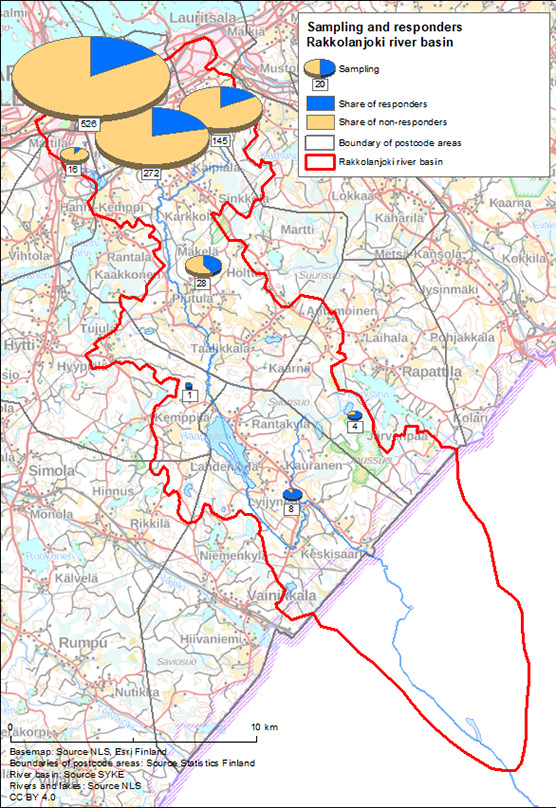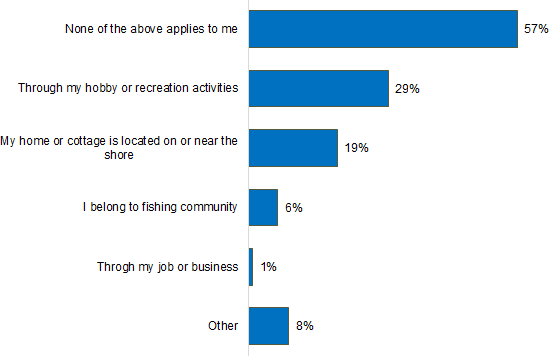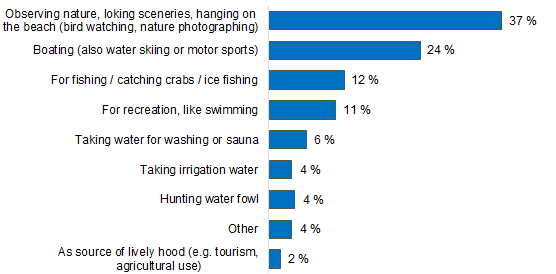
River Rakkolanjoki. © Eija Rantajärvi.
At the beginning of 2021, researchers from the Finnish Environment Institute SYKE and experts from the City of Lappeenranta conducted a citizen survey concerning water bodies in the Rakkolanjoki catchment area as part of the SEVIRA project. The questionnaire was sent at random to 1,009 permanent and holiday residents in the area and produced a total of 242 responses. 214 responses ended up in the final analysis.

Map 1. Sampling of the Rakkolanjoki catchment area and proportion of respondents.
For many respondents, the water bodies of the catchment area were unknown; there are only small number of summer cottages in the area and only few residents earn their living from forestry or agriculture. For less than one out of five (19 percent) respondents, a home or summer cottage is located on or near a water body (figure 1). Lake Haapajärvi was the best-known water body for 26 percent of the respondents and River Rakkolanjoki for 13 percent of the respondents. 17 percent of the respondents said that Lake Saimaa or Pien-Saimaa outside the study area was the most familiar water body. As expected, the highest number of received responses came from the northern parts of the catchment area, as most of the population in the catchment area are in the northern part in or near the city of Lappeenranta. However, the response activity was higher in the lower parts of the catchment area (map 1).
How do water bodies in the area link to you? (n=214)

Figure 1. Answers to the question of how the water bodies in the area relate to the respondent, question 2 of the questionnaire.
When asked about the importance of some issues to be promoted with public funding in the area, the development of health services or the road network was considered more important than improving water quality in Lake Haapajärvi and / or River Rakkolanjoki. On the other hand, improving the condition of the waters was more important than the construction of a new multi-purpose hall or the promotion of Russian tourism.
Have you used the water bodies in the area and/or their shores during the past three years? (N=214)

Figure 2. Respondents' uses of water bodies in the last three years, question 3 of the questionnaire.
The survey results showed that a large proportion of respondents (44 percent) have not used the area’s water bodies or their shore areas at all in the past three years. 37 percent of the respondents observe the landscape or nature from the shores, and 24 percent of the respondents use waters to recreation purposes. About four percent of the respondents take irrigation water from the local waters (figure 2).
The poor state of the waters surprised many respondents. The map of the ecological status of the water bodies was presented to the respondents and to 37 percent of the respondents it came as a surprise “I did not know that the catchment area was in such a poor condition.” or “I did not expect yellow (i.e., the color that describes a satisfactory ecological status) to occur so much. The situation needs to be addressed urgently."
Two things arose as the main goals of water management: improving water quality, which was clearly the most important goal among 62% of respondents. The importance of the migration of migratory fish or the management of fish stocks was highlighted by up to 75% of respondents.
Respondents were asked if they were willing to monitor waters as volunteers over the next three years. About 16 percent of respondents indicated that they were interested in, for example, monitoring the littering of water bodies, the transparency of waters or the algal situation. The proportion corresponds well to the number of respondents who already observe nature, for example the time of ice departure, migratory birds, or the weather (16 percent of respondents). Almost every respondent (90%) felt that the survey provided them new information on the state of the waters in the catchment area or how citizens could be involved in monitoring the status (86 percent).
The survey presented an imaginary situation in which a local water management and restoration association would be established in the area. A clear majority, 61 percent of respondents, would not be willing to pay an annual membership fee to such association, 7 percent would be willing to pay, and 32 percent could consider paying if the association were established in the region.
New ideas for water management in the Rakkolanjoki watershed
The survey also provided ideas for water management in the Rakkolanjoki watershed. The 27 proposals for actions on wastewater treatment or the conditions of migratory fish, included e.g., these suggestions:
“I would like a quick schedule for the implementation of the new wastewater treatment plant. In my opinion, the chosen cleaning method as well as the reliability of the plant should aim at complete cleaning. Quality should definitely be the primary criterion when deciding. Clean water and well-maintained water bodies are our immeasurably valuable assets.”
“… There is a lot to do in the management of streams and river waters flowing east, before the trout rises into River Rakkolanjoki. The work is also international.”
More information
- Of the survey (report is available only in Finnish)
development engineer Virpi Lehtoranta,
Finnish Environment Institute SYKE, firstname.lastname@syke.fi
- Of the SEVIRA project
project coordinator Kai Myrberg,
Finnish Environment Institute SYKE, firstname.lastname@syke.fi